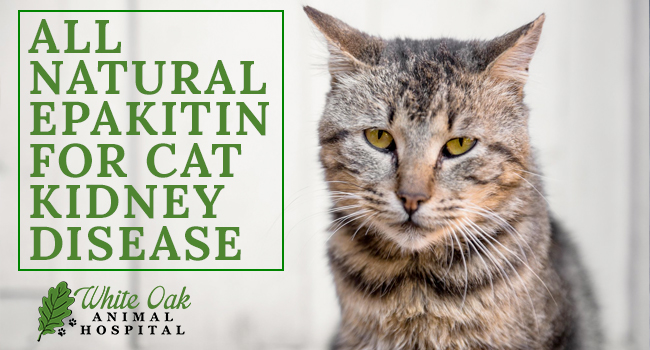
Cat kidney disease is a common ailment in older cats.
For example, common causes of cat kidney disease include:
- Kidney infections and blockages
- Advanced dental disease
- High blood pressure
- Old age
Luckily, veterinarians offer natural and effective treatments for addressing cat kidney disease.
Kidney Disease Symptoms
Cats with advanced kidney disease or renal failure will appear very ill.
For example, cats suffering from renal failure often experience:
- Bladder and kidney infections
- Bloody or cloudy urine
- Brownish-colored tongue
- Diarrhea or constipation
- Dry coat
- Excessive drinking
- Frequent urination
- Lethargy
- Ulcers on gums and tongue
- Vomiting
- Weakness
- Weight loss
However, some of the earlier signs are not very noticeable.
Testing might include:
- Firstly, blood tests
- Second, urinalys
- Third, x-rays
- Fourth, ultrasound
- Lastly, biopsy
Cat Kidney Disease Treatment With Epakitin
Depending on the severity, treatment may include:
- IV Fluids
- Special diet
- Pharmaceuticals
- Surgery
However, Epakitin is a nutritional supplement designed to help slow down the progress of cat kidney disease.
Additionally, Epakitin comes in a powder form and supports kidney function safely and effectively.
Moreover, Epakitin works well in combination with PET | TAO Kidney Treats for cats.
Why Use Epakitin For Cat Kidney Disease?
Epakitin is a chitosan-based phosphate binder and uremic reducer.
Additionally, it contains lactose, calcium carbonate, chitosan, and hydrolyzed soy protein.
Moreover, lactose and hydrolyzed soy provide protein and carbohydrates.
Furthermore, studies show managing phosphate enhances renal function.
This product has been clinically proven to reduce urea, creatinine, calcium absorption and decrease phosphatemia leading to an increase in life expectancy without affecting food consumption.
Importantly, Epakitin is reported to prevent future kidney damage and improve the pet’s quality of life.
Why Chitosan For Cat Kidney Disease?
Chitosan is a natural polysaccharide extracted from crab and shrimp shells.
According to research by the Memorial Sloan-Kettering Cancer Center, Chitosan works by forming a “positively charged gel matrix in stomach acid able to bind bile acids, nitrogen metabolites, phospholipids, unesterified cholesterol, fat-soluble vitamins, and calcium.”
Furthermore, a 12-week study using 1450 mg of Chitosan per day showed reduced serum cholesterol, increased mean serum hemoglobin, reduced BUN, and reduced creatine in the group taking Chitosan as compared to the control group.
Additionally, the treatment group also showed improved appetite, sleep, and feelings of physical strength.
Moreover, a study on rats fed either Chitosan, Kremezin, or a normal diet showed the rats fed Chitosan showed marked prolongation of the survival period.
Furthermore, they showed decreases in blood urea nitrogen, serum creatine, serum phosphate, and protein ratio compared to the group fed Kremezin or a regular diet.
The other groups showed increases during the same period.
How To Use Epakitin For Cat Kidney Disease
Directions For Using Epakitin:
- 1g/5kg body weight given orally in the morning and the evening. One kg is 2.2lbs.
- One level spoonful (provided) contains 1 gram of Epakitin.
Furthermore, pets may experience mild side effects of Epakitin. These include lack of appetite, behavior changes, lethargy, and hypercalcemia (if given higher than recommended dose).
Next, learn more about Epakitin and how it can help manage your pet’s cat kidney disease on TCVM Pet Supply.